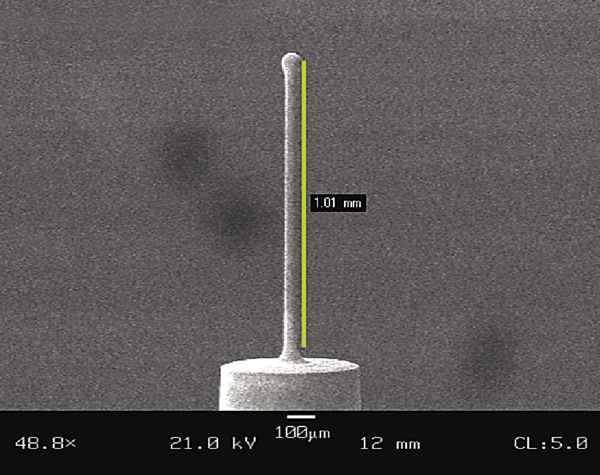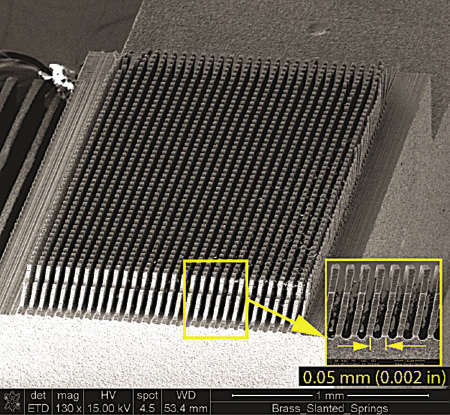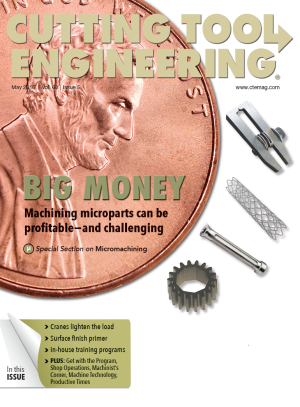Say “EDM” and most manufacturing folks think mold, tool and die work. Yet sinker, wire and hole-popping EDMs are often employed in conjunction with, or as alternatives to, traditional part-making processes, such as milling and turning.
EDMing is generally much slower than chipmaking processes, which limits its use to parts where the metal is too hard, the geometry too difficult or part features too small for conventional cutting tools.


This microprobe uses the “prespark” electrical fields generated during EDMing to build 3D models of the workpiece. Image courtesy SmalTec International.

Some parts, especially those in the medical and semiconductor industries, meet all three criteria and arrive on the doorstep of someone like Eberhard Bamberg, president of Viteris Technologies LLC, Salt Lake City. Bamberg designs, builds and operates micro-EDMs and defines “micro” as anything smaller than 0.0004" (10µm). And while his definition is more restrictive than what most in the EDM community consider micro (objects smaller than 1mm), Bamberg’s equipment addresses the more common problems associated with micro-EDMing, starting with the electrode.
“From a mechanical point of view, getting the right tension on a wire measuring 0.002" and smaller is extremely challenging,” Bamberg said about the typical wire size the company uses. “There’s almost no margin for error, especially with tungsten, which is what we typically use in this range.”
In addition to gentle methods of wire handling, Viteris also needed to develop its own spark generators, because the current-carrying capacity of electrodes in this size range is limited—a little too much on-time or amperage microspike and the wire is likely to blow apart.


An array of ultrasmall brass springs created with 0.0004"-dia. tungsten wire, one-tenth that of a human hair. Image courtesy Viteris Technologies.

Jerry Mraz, general manager of machine tool builder SmalTec International LLC, Lisle, Ill., also had to develop spark generators for the company’s equipment, which uses a wire to dress the sinker electrode. He said micro-EDMing isn’t as much about part size as it is surface finish.
“We’re able to achieve 40nm or less of surface variation,” Mraz said. “This makes it possible to do extremely fine mold work, for example, or very small part features. One of our current projects requires a series of 4mm-long channels
measuring 12µm to 15µm wide and twice that deep.”
Mraz said the energy discharge is so insignificant at this level it can’t really be considered EDMing. “You’re basically just stripping away ions and molecules, rather than eroding material. It’s similar to electrochemical machining, except we use deionized water rather than electrolyte and, unlike ECM, there is some small amount of electrode wear. The toolpath is also different than with conventional EDMing, in that the tool motions are like those used in a milling machine.”
Metrology is another problem plaguing micro-EDMers. SmalTec’s equipment comes with optical measurement capability, but Mraz has developed a new micro-electrical-discharge-based system—electrical flux metrology—for which he recently received a patent. The new system passes a small amount of current into an electrode, then measures its position at the point in space just before the spark jumps to the workpiece. By collecting these predischarge locations, Mraz is able to build a 3D model of the surface being measured.
“A lot of customers are EDMing quite deep at a very small scale,” he said, adding that this includes tiny orifices and channels that are a nightmare to measure because the majority of metrology systems are unable to see the bottom of these features. “Even white-light systems struggle.”

Contributors
SmalTec International LLC
(630) 364-1788
www.smaltec.com
Viteris Technologies LLC
(801) 886-9424
www.viteris.com
Contact Details
Related Glossary Terms
- electrical-discharge machining ( EDM)
electrical-discharge machining ( EDM)
Process that vaporizes conductive materials by controlled application of pulsed electrical current that flows between a workpiece and electrode (tool) in a dielectric fluid. Permits machining shapes to tight accuracies without the internal stresses conventional machining often generates. Useful in diemaking.
- electrochemical machining ( ECM)
electrochemical machining ( ECM)
Operation in which electrical current flows between a workpiece and conductive tool through an electrolyte. Initiates a chemical reaction that dissolves metal from the workpiece at a controlled rate. Unlike with traditional cutting methods, workpiece hardness is not a factor, making ECM suitable for difficult-to-machine materials. Takes such forms as electrochemical grinding, electrochemical honing and electrochemical turning.
- electrochemical machining ( ECM)2
electrochemical machining ( ECM)
Operation in which electrical current flows between a workpiece and conductive tool through an electrolyte. Initiates a chemical reaction that dissolves metal from the workpiece at a controlled rate. Unlike with traditional cutting methods, workpiece hardness is not a factor, making ECM suitable for difficult-to-machine materials. Takes such forms as electrochemical grinding, electrochemical honing and electrochemical turning.
- gang cutting ( milling)
gang cutting ( milling)
Machining with several cutters mounted on a single arbor, generally for simultaneous cutting.
- metrology
metrology
Science of measurement; the principles on which precision machining, quality control and inspection are based. See precision machining, measurement.
- milling
milling
Machining operation in which metal or other material is removed by applying power to a rotating cutter. In vertical milling, the cutting tool is mounted vertically on the spindle. In horizontal milling, the cutting tool is mounted horizontally, either directly on the spindle or on an arbor. Horizontal milling is further broken down into conventional milling, where the cutter rotates opposite the direction of feed, or “up” into the workpiece; and climb milling, where the cutter rotates in the direction of feed, or “down” into the workpiece. Milling operations include plane or surface milling, endmilling, facemilling, angle milling, form milling and profiling.
- milling machine ( mill)
milling machine ( mill)
Runs endmills and arbor-mounted milling cutters. Features include a head with a spindle that drives the cutters; a column, knee and table that provide motion in the three Cartesian axes; and a base that supports the components and houses the cutting-fluid pump and reservoir. The work is mounted on the table and fed into the rotating cutter or endmill to accomplish the milling steps; vertical milling machines also feed endmills into the work by means of a spindle-mounted quill. Models range from small manual machines to big bed-type and duplex mills. All take one of three basic forms: vertical, horizontal or convertible horizontal/vertical. Vertical machines may be knee-type (the table is mounted on a knee that can be elevated) or bed-type (the table is securely supported and only moves horizontally). In general, horizontal machines are bigger and more powerful, while vertical machines are lighter but more versatile and easier to set up and operate.
- toolpath( cutter path)
toolpath( cutter path)
2-D or 3-D path generated by program code or a CAM system and followed by tool when machining a part.
- turning
turning
Workpiece is held in a chuck, mounted on a face plate or secured between centers and rotated while a cutting tool, normally a single-point tool, is fed into it along its periphery or across its end or face. Takes the form of straight turning (cutting along the periphery of the workpiece); taper turning (creating a taper); step turning (turning different-size diameters on the same work); chamfering (beveling an edge or shoulder); facing (cutting on an end); turning threads (usually external but can be internal); roughing (high-volume metal removal); and finishing (final light cuts). Performed on lathes, turning centers, chucking machines, automatic screw machines and similar machines.


